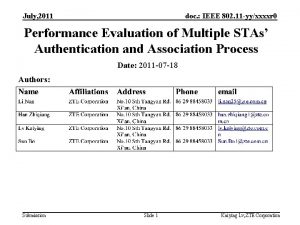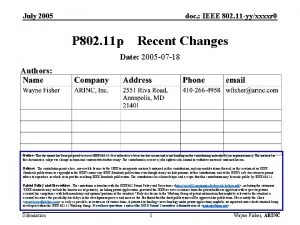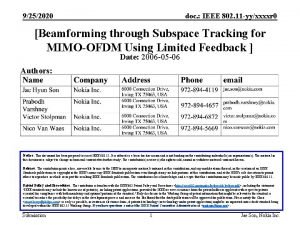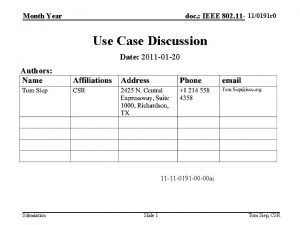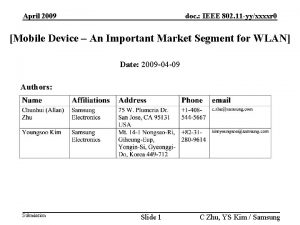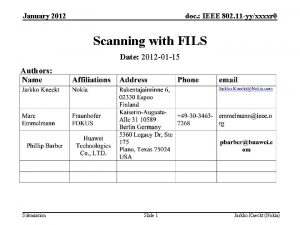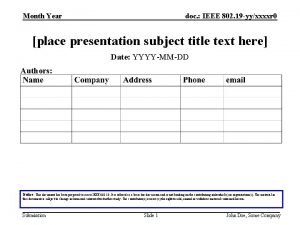doc IEEE 802 11 yyxxxxr 0 July 2011










- Slides: 10

doc. : IEEE 802. 11 -yy/xxxxr 0 July 2011 Group Addressed MSDUs in 802. 11 ac Date: 2011 -07 -12 Authors: Submission Slide 1 Jarkko Kneckt, Nokia

doc. : IEEE 802. 11 -yy/xxxxr 0 July 2011 Abstract The presentation provides means to improve the group addressed MSDUs transmission efficiency, and to reduce power consumption of the STAs. The presentation solves the following CIDs: 2614, 2631, 2740, 3704, 2615, 2632, 3702, and 3705. The group addressed frames transmission efficiency is improved: Ø RTS CTS prior group addressed frames transmission Ø TXOP of group addressed frames The power consumption of group addressed frames reception is reduced: Ø The TA and (RA or frame type) indication in PLCP headers Submission Slide 2 Jarkko Kneckt, Nokia

doc. : IEEE 802. 11 -yy/xxxxr 0 July 2011 Recap, clause 9. 3. 6 group addressed MPDU transfer procedure • Clause 9. 3. 6 defines: “ In the absence of a PCF, when group addressed MPDUs in which the To DS field is 0 are transferred from a STA, only the basic access procedure shall be used. Regardless of the length of the frame, no RTS/CTS exchange shall be used. ” • It is unclear what is basic access procedure – Only one PPDU may be transmitted in a TXOP? • RTS CTS cannot be used prior group addressed MPDUs transmission – The CCA sensing is only performed at the transmitter which may lead to transmission collisions and hidden node problems – The larger transmission bandwidth makes collisions of the transmissions even more likely Submission Slide 3 Jarkko Kneckt, Nokia

doc. : IEEE 802. 11 -yy/xxxxr 0 July 2011 RTS CTS for Group Addressed • Enable RTS CTS signaling prior group addressed frames transmission – RTS is addressed to an individual address of a STA in BSS – The STA responds with CTS frame – Group addressed frames are transmitted • The level of RTS CTS protection for group addressed frames is similar to protection level of MU MIMO transmissions – In both cases data is transmitted to multiple devices and RTS CTS exchange is done with a single STA Submission Slide 4 Jarkko Kneckt, Nokia

doc. : IEEE 802. 11 -yy/xxxxr 0 July 2011 RTS CTS for group addressed frames • Both the RTS transmitter and CTS transmitter perform virtual carrier sensing in primary channel and CCA sensing in non-primary channels – RTS CTS avoids collisions with ongoing transmissions – RTS CTS is the only mechanism to avoid OBSS problems – RTS CTS distributes NAV to non-primary channels to ensure the protection for the transmission Submission Slide 5 Jarkko Kneckt, Nokia

doc. : IEEE 802. 11 -yy/xxxxr 0 July 2011 TXOP for Group Addressed Frames • The TXOP enables transmission of multiple MPDUs with the same contention – Reduced amount of contentions improve transmission efficiency – NAV protection avoids transmission collisions – The same mechanism (TXOP) is used for group addressed and individually addressed MPDUs • The group addressed frames should be transmitted to all receivers, i. e. transmission rate is typically low – The aggregated MPDU may require very long transmission time Submission Slide 6 Jarkko Kneckt, Nokia

doc. : IEEE 802. 11 -yy/xxxxr 0 July 2011 Recap, Address Indication in PLCP Header • 802. 11 ac PLCP header indicates: – Individually addressed PPDU to single user (SU) • The partial AID defines the BSSID and AID of the receiver – Individually addressed aggregated PPDU (A-PPDU) to multiple users (MU) • The Group ID defines the receivers – Group addressed PPDU • The partial AID set to 0 indicates group address MPDU transmission in any BSS – The partial AID set to 0 indicates frame transmission in a IBSS – The same partial AID value 0 should not be used for multiple frame type transmissions Submission Slide 7 Jarkko Kneckt, Nokia

doc. : IEEE 802. 11 -yy/xxxxr 0 July 2011 Challenges of the Address Indication in PLCP Header • Currently PLCP header has partial AID set to 0 for group addressed frames – The same value is used for all frames transmission in IBSS • STAs cannot detect from PLCP header: – Transmitter Address (BSSID) – Is the PPDU transmitted in IBSS or is it group addressed frame transmitted in a BSS • The current format forces STAs to receive all group addressed PPDUs – Device cannot filter frames from other BSSIDs Submission Slide 8 Jarkko Kneckt, Nokia

doc. : IEEE 802. 11 -yy/xxxxr 0 July 2011 Partial AID • All frames, individually and group addressed frames, use the same rule to generate the partial AID • Partial AID for group address is generated: – AID = 0 (AID value 0 indicates group addressed frame) – BSSID = BSSID • This enables to detect TA and that frame type is group addressed frame – The power consumption of the devices is improved, because the STA filters unnecessary transmissions from other BSSs and IBSS – No need to reserve new bit combinations Submission Slide 9 Jarkko Kneckt, Nokia

doc. : IEEE 802. 11 -yy/xxxxr 0 July 2011 Summary • The efficiency of the group addressed frames transmission is simple to improve in VHT BSSs – The individually and group addressed MPDUs should have the same capabilities for frames transmission and reception Submission Slide 10 Jarkko Kneckt, Nokia











